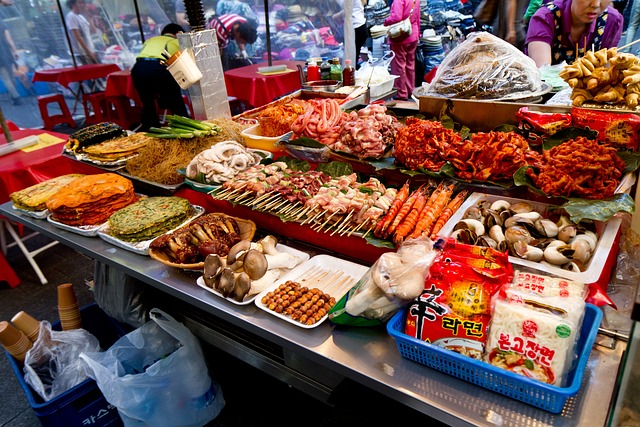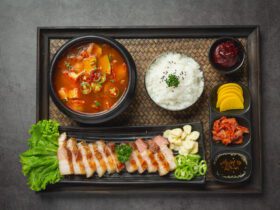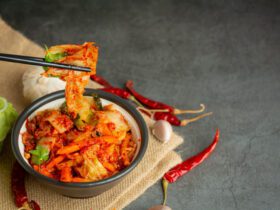Bold flavors, brilliant colors, and an emphasis on healthy ingredients are all hallmarks of Traditional Korean food. Korean cuisine, which has its roots in centuries of tradition, has developed into a cherished culinary art form that satisfies the palate and feeds the body.
Korean food has developed into a harmonic fusion of tastes, textures, and colors, with a history that spans thousands of years. It is a cuisine that treasures the ideas of harmony, balance, and wellness. Every cuisine, from simple street food, stands to elaborate royal feasts, tells a tale, and represents the special qualities of the Korean people.
From the fiery heat of kimchi to the comforting warmth of a bowl of bibimbap, let’s embark on a culinary journey into the world of traditional Korean food.
Bibimbap: Harmony in a Bowl

Bibimbap, which translates to “mixed rice,” is a beloved Korean dish that brings together an array of flavors and textures in perfect harmony. It consists of a bowl of steamed rice topped with an assortment of seasoned vegetables, marinated meat (usually beef), a fried egg, and gochujang, a spicy fermented red chili paste. The components are mixed together before eating, creating a delightful symphony of flavors.
The vibrant assortment of ingredients that go into making bibimbap adds to both its distinct flavor and attractive appearance. All you need to make your own bibimbap masterpiece is this mixture of fresh veggies, flavorful toppings, and basic white rice.
- White Rice: A foundation of fluffy white rice forms the base of bibimbap, providing a comforting backdrop for the medley of flavors to come. Opt for jasmine or sushi rice for the perfect texture.
- Assorted Vegetables: Bibimbap is celebrated for its variety of vegetables, including spinach, white onion, zucchini, soybean sprouts, carrots, cucumber, dried bellflower root (“doraji”), and dried fernbrake (“gosari”). These ingredients add both color and nutritional value to the dish, showcasing the bounty of nature’s harvest.
- Shiitake Mushrooms: Sliced shiitake mushrooms lend a rich umami flavor to bibimbap, enhancing its depth and complexity.
- Eggs: While optional, a perfectly cooked egg adds a luscious creaminess to bibimbap, elevating it to new heights of indulgence.
- Sesame Seeds: A sprinkle of crushed sesame seeds imparts a nutty aroma and subtle crunch, enhancing the overall texture of the dish.
- Garlic and Soy Sauce: These essential seasonings infuse bibimbap with layers of savory goodness, tying together its diverse components into a cohesive whole.
- Hot Sauce: For those who crave a spicy kick, a drizzle of your favorite hot sauce provides the perfect finishing touch, adding a tantalizing heat to every bite.
Making Process:
Crafting the perfect bibimbap requires a careful balance of preparation and assembly. Here’s a step-by-step guide to bringing this iconic dish to life in your own kitchen:
- Preparation: Begin by soaking the dried fernbrake and bellflower root overnight to soften their texture and mellow their flavors. The next day, drain and rinse them thoroughly before cooking.
- Cooking Rice: Whether using a rice cooker or stovetop method, cook the white rice according to package instructions until tender and fluffy.
- Preparing Vegetables: Blanch the spinach, sauté the remaining vegetables individually, and season each with a touch of salt and garlic to enhance their natural flavors.
- Assembly: Arrange the cooked rice in bowls and top with portions of each vegetable, ensuring a vibrant and visually appealing presentation. For added flair, place an optional egg on top and sprinkle with sesame seeds.
- Final Touches: Drizzle with sesame oil and hot sauce to taste, then gently mix everything together to evenly distribute the flavors.
Kimchi: The Heart and Soul of Korean Cuisine
It would be impossible to discuss Korean cuisine without discussing kimchi. This traditional Korean food has a history extending back more than 2,000 years to the Shilla Dynasty. People usually use cabbage or radishes for kimchi. All the ingredients usually seasoned with salt, chili pepper flakes, garlic, ginger, and other herbs and spices. The end result is a dish that Koreans adore with every meal because it is sour, hot, and pungent. Due to its probiotic nature, kimchi is not only delicious but also has several health advantages.

Tteokbokki- Red Rice Cakes

Tteokbokki is a beloved traditional Korean food that has become a popular street food dish across the country. It features chewy rice cakes, known as tteok, cooked in a spicy sauce, creating a flavorful and satisfying meal. Tteokbokki is known for its unique combination of heat, sweetness, and umami flavors.
Method
Tteokbokki is a popular Korean meal made using the well-known rice cake called tteok. This recipe offers a tasty, easy, and satisfying experience for both beginner and seasoned cooks.
- Tteok, or Korean rice cakes, are the main ingredient of tteokbokki. Packaged types of rice cakes are equally effective as fresh ones. Tubular “stick-type” rice cakes are readily available in the frozen or refrigerated areas of Korean grocery shops. To cook, either give the chilled ones a quick rinse or thaw the frozen ones in warm water for ten minutes or so.
- Accompanying the rice cakes are Korean fish cakes, also known as Eomuk. These thin sheets of delight are typically found in the freezer aisle of Korean markets. While traditional recipes call for fish cakes, you can still whip up a delicious Tteokbokki using solely rice cakes.

- Let’s speak about sauce now. The sauce, a flavorful mixture of soy sauce, sugar, garlic, honey, Gochugaru (Korean chili powder), and Gochujang (Korean chili paste), is the key to the dish’s deliciousness. It’s important to note that gochugaru is available in two forms: powder and flake. For the sake of this recipe, we’ll be utilizing the fine powder kind.
- As an alternative basis, try adding dashi or anchovy stock to enhance the dish’s flavor profile. If these aren’t available, though, ordinary chicken stock diluted with water or unsalted chicken stock can still work well.
- As a finishing touch, garnish your Tteokbokki with fresh green onions for a pop of color and flavor. With these simple ingredients and easy-to-follow steps, you’ll have a steaming pot of Tteokbokki ready to enjoy in no time.
Jajangmyeon – A Comforting Classic from Korean Cuisine
Jajangmyeon traces its origins to the Chinese immigrants who settled in Korea during the late 19th century. In jjajangmyeon, thick, hand-made wheat noodles combine with salty black soybean paste, chopped pork, and veggies. The dark sauce known as jajang, a base made from stir-fried chunjang (fermented black bean paste), chopped beef or pork, onions, and other vegetables, constitutes the main component of Jajangmyeon.
Additionally, individuals typically consume it on Black Day, an annual observance that falls on April 14.On Valentine’s Day, those who do not receive gifts dress in all black and congregate to eat foods in black color, including jjajangmyeon.

Bulgogi: Grilled Delight

Bulgogi, meaning “fire meat,” is a quintessential Korean barbecue dish. Marinate thinly sliced beef, usually sirloin or rib-eye, in a mixture of soy sauce, sugar, sesame oil, garlic, and other seasonings before grilling it to perfection. The result is tender, juicy, and caramelized meat that is bursting with savory and slightly sweet flavors. You can enjoy bulgogi wrapped in lettuce leaves along with rice.
Making Process :
Bulgogi, which translates literally as “fire meat,” is a symbol of Korea’s rich culinary history. It’s a multisensory experience that entices taste senses and stokes desire for Korean cuisine, more than just grilled meat.
- The marinade, a symphony of aromas that turns regular beef into a culinary masterpiece, is the key ingredient in bulgogi. Garlic, ginger, pear, and a touch of heat from Korean chili flakes and Sambal chile sauce are added to the marinade, which is a well-balanced combination of tart, sweet, and savory flavors. Every family has added their own unique touch to the recipe, which has been handed down through the decades.
- This delicious creation thinly slices sirloin or rib-eye steak. The secret lies in cutting them paper-thin, allowing the marinade to absorb as much as possible, whether you purchase them from a Korean market or cut them yourself. The meat absorbs the essence of each ingredient while it marinates, ensuring a flavor explosion with every mouthful.

- After marinating, the meat is ready for grilling or cooking on a flat surface, where it will sizzle and caramelize to perfection. One just has to smell the scent of bulgogi to get hearts to beat with anticipation and mouths to wet. The meat acquires a seductive char during cooking, which enhances the complexity of its flavor profile.
- Serve it over fluffy rice or tucked into a brioche roll with thick slices of orange cheddar cheese, bulgogi is a world-class dish. This meal has the power to unite people, sparking lifelong memories and conversations.
So, light up the grill and relish the flavorful perfection of bulgogi the next time you’re craving anything Korean. Bulgogi will not disappoint, whether it is consumed as a filling dinner or as a delicious snack. It will leave you hankering for more. Enjoy the grilled delicacy known as bulgogi, which will transport you to the magical world of Korean food.
Jjigae-Korean stew
In Seoul, a wide range of variations of jjigae includes meat, seafood, or vegetables in a broth spiced with gochujang, gaenjang, soybean paste, or salty fermented shrimp (saeujeot). Jjigae, with a consistency akin to a Western stew, is a dish that people frequently serve as a palette cleanser in between heavier courses.
Budae jjigae (army stew), which includes bacon, sausages, and Spam meat as well as ramyeon noodles and rice cakes blended with gochujang paste for a spicy flavor, is one of the most well-known jjigae dishes in Seoul.

Samgyeopsal: Pork Belly Extravaganza

A popular Korean barbecue dish called samgyeopsal, which means “three-layered meat,” uses thick slices of pig belly. Samgyeopsal is grilled at the table. It delivers a delicious combination of luscious, fatty meat. Korean people eat this with garlic, green chilies, and ssamjang, a hot dipping sauce, wrapped in lettuce leaves. Samgyeopsal is made to be enjoyed in a group setting by grilling and sharing it.
Gimbap: Seaweed-Wrapped Rolls of Korean Delight
Popular traditional Korean food called gimbap is similar to sushi rolls. Someone encases seasoned rice and a variety of fillings in a thin sheet of toasted seaweed. Typically, the fillings consist of boiled eggs, vegetables, and occasionally meat. Its distinctive combination of flavors and textures makes it a popular Korean treat. Gimbap is easy to carry that’s why it is very popular as a snack or brought in lunch boxes.

Korean Fried Chicken: The Crispy Delight of Traditional Korean Food

Korean fried chicken recreates the classic American fast food in its own special way. Unlike its American equivalents, double-fry the chicken in vegetable oil before covering it in a sweet-spicy sauce. As a result, the inside of the meat is extremely moist. And the lightly battered skin is crispy and low in fat. Korean Fried Chicken is a famous late-night treat with beer.
Ginseng Chicken Soup (Samgyetang): A Nourishing Elixir of Korean Cuisine
Ginseng Chicken Soup is a traditional Korean dish. It is renowned for its nourishing qualities. It features a young chicken stuffed with glutinous rice, garlic, jujubes, and ginseng, simmered in a flavorful broth. Ginseng, a prized medicinal herb, provides a subtly earthy flavor and potential health benefits. Enjoy the hot soup accompanied by side dishes for a balanced and revitalizing meal.

Traditional Korean cuisine is a vivid tapestry of tastes, textures, and cultural importance. Whether you enjoy the crisp thrill of Korean fried chicken or the comfortable simplicity of gimbap. Exploring the world of traditional Korean cuisine will capture your taste buds and leave you wanting more.







2 Comments